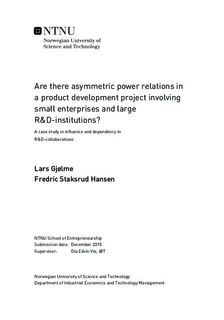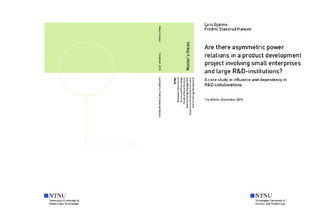| dc.description.abstract | The objective of this thesis is to answer the main research question: Can we observe the existence of power imbalance in R&D-collaboration, and how is this power imbalance formed by dependency and influence? The main research question is separated into three subordinated research questions; (1) can we identify an asymmetric power balance between research institutions and small enterprises? (2) How is the power distribution between the research institution and customer company in relation to influence? (3) To which degree is the small enterprise dependent on the research institution, and how can the small enterprise obtain a level of dependency that optimizes the value of the collaboration?
The approach is a descriptive case study of four separate R&D-projects involving SINTEF and one small company. The empirical data is gathered from ten individual interviews with representatives from SINTEF and representatives from their customers. The theoretical basis is a preliminary literature study by Gjølme and Staksrud Hansen (2014) with a supplemental literature study. The theory researched is within power, which is a controversial and comprehensive field of research - subject to tension between researchers all over the world. One of the main topics that are discussed is the basics of power theory - what is the definition of power, and how do you achieve a power submissive or dominant position towards another? In this thesis, we have viewed power as an outcome of two distinct relative power sources Influence and Dependency. Two separate frameworks have been developed to visualise grades of influence and dependency, based on separate dimensions or principles. The findings from these frameworks are discussed to answer ten theory-based propositions used to conclude the research questions.
The main conclusions are that asymmetric power balance might occur in R&D-collaborations, but the asymmetry often varies based on the customer company s experience. An important discovery is that the power asymmetry does not have a negative impact on the process as the more experienced part tries to compensate for the lack of experience with the other actor. This is considered as an advantageously power execution, if the power dominance is positive. A less sensational discovery is that these projects are similar to other projects, when it comes to planning, contracting and implementation.
The most influential implication is that the theory-based frameworks are functional to visualise grading of influence and dependency in an R&D-collaboration, and in the concluding chapter we present two sets of recommendations for optimising the collaboration, one set for the research institution and one set for the small company engaging the research institution. | |

